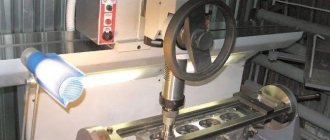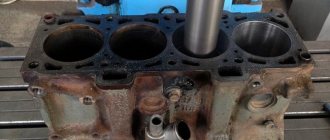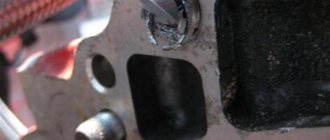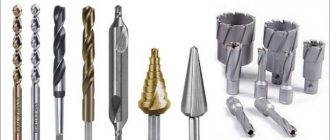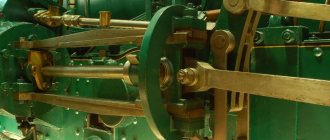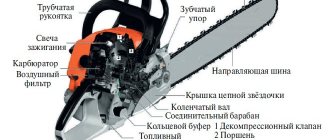Processing tool
For processing, a special honing tool is used - honing. Honing heads are classified according to the following characteristics:
- according to the method of fastening the abrasive tool: rigid;
- floating;
according to the method of ensuring the size:
- adjustable;
self-unclosing.
The honing head consists of:
- housings;
- abrasive bars;
- rod;
- control coupling.
The body has milled grooves into which abrasive stones are installed. A collet mechanism is provided inside the body, ensuring simultaneous and smooth ejection of the bars.
The coaxiality of the motor sleeve and the tool is ensured by the rod. The resulting hole diameter is adjusted using a coupling.
A little theory and technology
Honing
- (from the English honing, from hone - to hone, literally - to sharpen). A type of abrasive processing of materials using honing heads (honing heads). It is mainly used for processing internal cylindrical holes by combining the rotational and translational-reciprocal movements of the hone with sliding abrasive bars attached to it with abundant irrigation of the treated surface with a cutting fluid. Although external honing is also found, such an operation is performed on specialized machines. External honing is used on long parts, the processing of which in conventional metalworking machines is not possible. For example, the hydraulic brake rods of artillery guns. Honing of external surfaces can be carried out on modernized (grinding, horizontal boring) machines. Honing can be done on parts made of both ferrous materials (steel and cast iron) and non-ferrous materials (brass, bronze, aluminum zinc and magnesium alloys).
What car owners say about cylinder honing
- Honing on old engines Honing the cylinder block at Soviet enterprises in the 60–80s. was absent in principle. Automobile, boat and motorcycle engines were, as a rule, the result of side activities of the defense industry. Therefore, there was no incentive to introduce new technologies and improve existing products. People bought what was available and did not complain about the quality, because there was always a shortage and long queues for almost any product, including cars. The complication of technological operations was not welcomed in mass production, and in the absence of competition, the plant did not care how long its engine went through before a major overhaul.
- Non-factory honing A homemade hone may be no worse than a factory one, but the difficulty is that there is no information anywhere about the depth of the grooves, the honing angle, and the permissible surface roughness.
These parameters greatly affect the quality of lubrication and oil consumption. Oil starvation, as well as high consumption, will not make the engine long-lived. Increasing the honing pitch can lead to a reduction in oil film thickness and rapid engine wear. Therefore, car services, when honing a cylinder block, make certain average indicators that are suitable for a given type of engine (3L V6, for example). A lot depends on the machine equipment used. In boxer engines, the cylinder axis is horizontal, and therefore there is logic in changing the grid pitch and hone angle at the top and bottom of the cylinder. - Advantage of factory honing Repair honing of cylinders is significantly worse than factory honing. Flat-top honing can only be achieved in automotive production conditions. Car repair shops will not be able to handle such equipment, and the manufacturer has no interest in doing major repairs efficiently. When cutting a furrow with a hone, a turning and boring machine squeezes out a layer of metal on each side, which wears out the rings much faster during engine break-in.
- Honing Wear Uniformity Hon wears unevenly. Maximum wear occurs at the position of the upper compression ring at TDC of the piston. Above it, wear is significantly less.
- Same hone or different The honing angle is different for each engine and each manufacturer. It’s difficult to find exact numbers; you often have to look at how it’s done on similar engines. Once I was rebuilding the engine on a RAV4 using a manual hone. In appearance it is much worse than the factory one, but it still gives the effect. After manually honing the cylinder block and replacing the rings, oil consumption practically disappeared.
How to properly apply hone to cylinder walls
Let's start with the fact that the process of proper honing in a factory environment is quite complex. We'll talk about this a little later. As for the repair of internal combustion engines in car services or specialized workshops, cylinder honing occurs in two main stages:
- initial processing using bars with coarse abrasive attached to the hone head;
- final honing, which involves finishing the cylinder with a fine-grained abrasive. This abrasive allows for high-precision surface processing;
The complete end of the cylinder honing process is washing the cylinder block (BC) to remove metal shavings, as well as residual polishing pastes. Further, during the engine assembly process, you can count on the correct fit of the piston rings, quick grinding and high-quality sealing of the combustion chamber. Let us add that the abrasive for honing cylinders consists of both ceramic and diamond bars. A ceramic stone has certain advantages over diamond abrasives, since this type of honing stone is more durable, which ultimately determines the lower cost of ceramic honing compared to diamond solutions.
Now let's talk about professional honing, which requires the presence of expensive, complex equipment. Such honing is used during the manufacture of new internal combustion engines, as well as for the restoration of engines in conditions as close as possible to factory ones. Honing should be understood as creating on the cylinder wall not just a chaotic mesh, but a certain microprofile on the surface. In other words, the hone in the cylinder is a set of marks that intersect with each other. The depth of these marks and their location in relation to each other also play an important role. Compression in the cylinders, engine power, fuel and engine oil consumption for waste, as well as the service life of the entire CPG and the engine itself directly depend on these factors.
This angle is called the honing angle. There is also a dependence on the type of abrasive and its grain size, which affects the final quality and structure of the hone. The degree of surface roughness, depth and size of the marks applied depend on the type of honbrusk. The entire process of applying honing is divided into initial and finishing. At each stage different bars are used. Precise control of surface roughness is made possible by subsequent visualization of hone microprofile diagrams. The honing angle is set using special film templates.
- To form a surface at the initial stage of honing that is quite rough, has deep grooves and increased roughness, the use of a coarse-grain abrasive will be required. For this purpose, diamond honbrus are used, which are made on a copper base. The entire rough honing process is accompanied by an abundant supply of cutting fluid. This is necessary for effective removal of mechanical particles, abrasive residues, etc. from the area where the hone is applied.
- After diamond honing, the rough surface does not allow you to immediately begin installing the remaining elements of the internal combustion engine, since the rings and piston will not be able to work in such a cylinder. Sometimes diamond honing is an alternative power method for boring engine cylinders. The rough surface is then processed again with a finer abrasive. This treatment makes it possible to achieve the formation of a new microprofile on the cylinder walls. The final stage of the honing process is re-treatment with a fine-grained abrasive, which allows the cylinder to achieve the planned repair size.
- Upon completion of the formation of the “finishing” surface, the so-called additional honing brushing is additionally carried out. This procedure is not aimed at further boring the cylinder; the main task is to clean the previously obtained microprofile from remnants of honing abrasives. Brushing a cast iron cylinder also opens up the graphite grains. When applied to cast iron, this makes it possible to further reduce friction and reduce mechanical losses, as well as slow down wear. For brushing, brushes are used, which are based on nylon threads and also contain silicon crystals.
Let us add that honing also allows for the application of an additional layer of special anti-friction coatings. Both cast iron cylinder blocks and some cylinder heads made of aluminum alloys can be honed. Flat-top honing is very popular today, which is actually similar to the classical method. The differences between flat-top honing and the conventional method of applying hone are in the materials and bars that are used when processing with the flat-top method.
Carrying out work
To obtain a high-quality result, a honing machine is required. Such equipment is used in large specialized auto repair shops that repair diesel and gasoline engines.
The cylinder block is positioned and secured on the machine table so that the holes or liners are positioned strictly vertically. This is the main condition. The honing head is placed inside. The clutch adjusts the desired hole size.
The processing process is carried out using working fluids. Kerosene is used to process cast iron, and a mixture of kerosene and oil is used to process steel. Coolant emulsions are increasingly being used. For example, 7% aqueous solution of NSC-5.
Interestingly, during honing, the surface is hardened to a depth of 0.06 mm. When the pressure of the abrasive bars is equal to 5 kgf/cm2, the hardness increases by 10−15%. When processing alloy steels and a pressure of 70 kgf/cm2, the hardness value increases to 70%.
Caseless engines
Hone treatment differs on liner and linerless engines. If you need to process a linerless cylinder block, there should not be any particular difficulties.
The solid metal structure is securely fixed to the machine table immediately after the boring process. You should make sure that the sleeves are positioned strictly vertically and that no displacements will occur during the reciprocating movement of the cartridge - otherwise there will be no benefit from the processing.
When machining linerless cylinders, only a few machine passes are required.
In this case, it is necessary to strictly control the resulting dimensions and surface roughness. An indicator bore gauge (monitors dimensions) and a profilometer or optical device for measuring the level of roughness will help with this.
But why "Mechanics"?
We mentioned above - and for good reason. He is a recognized expert in engine repair. And here are the arguments.
Automotive engines are changing rapidly. The power increases while the size of the unit is reduced. Thermal and mechanical stress on parts is increasing. This means that structural materials for piston rings, pistons and cylinder blocks are being improved. The rings themselves also change - their height decreases, and the number of rings decreases.
You need to know all this, continuously monitor all industry news, and above all, innovative solutions from engine manufacturers.
So, Mekhanika employees keep their finger on the pulse of the global automotive industry. But classical technologies are not forgotten either. Therefore, both the good old naturally aspirated engine and the newest turbocharged unit, born under the downsizing banner, will be repaired here.
As already mentioned, accurate diagnostics are carried out here. This means choosing the right repair technology.
This company has an excellent machine fleet, including modern Sunnen honing machines. And experienced craftsmen work for them. These will not “loose” tolerances; they feel the metal intuitively.
(photo: BC honing machine)
The tools - honing stones and brushes - are imported here. Cutting fluid (coolant) of the highest quality. It washes the instrument and block during the operation, is immediately filtered and again supplied to the working area.
Boring will help increase the compression of the cylinder block
Video instructions, as a rule, clearly show this event, but the viewer misses the most important thing - the specifics of the event. It seems to him that everything is simple and easy, and he can handle it, but we must not forget that in the video a pro is boring the block
Most of all, cylinder block boring is of interest to car owners concerned about compression. Watching a lot of videos becomes a revelation for many. They understand that dealing with this matter correctly at home will be extremely difficult.
As you know, if the cylinder compression is insufficient, the internal combustion engine cannot produce the required power, and the car’s dynamics decrease. Boring helps to significantly increase power by increasing the compression area on the cylinders.
Despite the fact that many experts recommend performing the operation in a car service center, there are more and more people who want to master the nuances of the operation. And this is not limited to video views alone. In search of useful information, an interested car enthusiast spams forums and websites, trying to find easy-to-understand instructions, but in most cases in vain.
Boring and honing stages
The problems described above entail repair of the power unit. If this is not done on time, the condition of the cylinders may adversely affect the performance of other mechanisms, which will lead to more serious breakdowns. There are cases when, as a result of postponing repairs, it was necessary to replace the entire crank mechanism.
The repair takes place in several stages:
- The worker bores all the liners in accordance with a certain repair size. If repairs have never been performed before, boring is done to the first size. Be sure to allow a few millimeters of allowance.
- Honing is performed to give the liners the correct shape and to reduce roughness.
Boring and honing is carried out in stages:
- First, rough processing occurs. It is made using coarse abrasive materials. The original form is returned.
- The cylinder is bored using a special abrasive. Honing occurs using diamond or ceramic coated timber. The stone is located on the honing head, which rotates and performs upward and downward movements. This device makes it possible to have high accuracy during the honing process. Scratches are removed from the surface of the cylinders using abrasive materials, so an acceptable degree of roughness occurs.
- At the end of honing, the surface of the treated cylinder is cleared of debris.
- Some specialists clean the surface using a special paste.
Additional recommendations
Various video instructions that can be found on the Internet describe replacing engine mounts as a simple procedure. Because of this, there is a feeling that anyone can replace the part, allocating a few minutes of free time for all this. But practice says the opposite. Lack of free space and poor access to parts create additional difficulties, which is why a seemingly simple job drags on for the whole day.
How to replace engine mounts
But in order for the repair work to proceed fairly quickly and efficiently, you need to follow a few simple recommendations:
- When lifting the power unit, the jack must be placed under the clutch bell. A wooden spacer must be substituted;
- Do not raise the engine too high, otherwise some parts or body elements may be damaged;
- a control check of the fasteners on the new support will not be superfluous;
- when installing the cushion, you need to get into the groove on the beam with the lower pin, which is on the body of the part;
- The right support must be protected by a heat shield. Otherwise, the new part will not last long under the influence of high temperatures from the exhaust.
Don't be lazy to use WD-40
Professional Services
If the wear is already significant (for example, when the ellipse of the cylinder exceeds 0.1 mm and the taper exceeds 0.2 mm), it is necessary to bore the cylinders to repair size. In this case, you need to buy special pistons, the diameter of which is larger than the standard ones. The cylinder block must be bored in a specialized workshop. It is impossible to perform this operation in a garage environment. Accuracy tolerances are very strict - tenths of a millimeter. Only professionals equipped with modern equipment can perform this work efficiently.
How is boring done?
At the first stage, the sleeve is bored at low speed. Due to the high strength of the alloy, high speeds are contraindicated - accuracy will suffer. When processing metal at low speeds, the top layer is subject to structural damage, so it must be removed. This is why honing is needed. This technological operation allows you to correct minor flaws that are inevitable when boring. Honing treatment allows you to bring the cylinder bore to a perfectly round shape (with proper honing, the ellipse is no more than 0.03 mm).
Honing after boring is performed in two stages. First, the walls are treated with coarse abrasive. Then finishing is done with fine-grained stones. The engine and machine are securely mounted on a special stand. Cooling and lubricating fluid is continuously supplied to the working area. At the final stage, the treated surface must be washed with soapy water to remove chips and abrasive particles. Diamond hones are almost universally used in professional equipment - they are more economical than ceramic ones.
To reduce wear of parts when running in the piston ring-liner assembly, it is recommended to use the Active Plus engine additive from . This tribological composition is specially designed to create conditions for comfortable operation of the power unit. The composition optimizes the gaps in piston-liner pairs, thereby equalizing compression across the cylinders. Suprotec Active Plus also increases the efficiency of hydraulic compensators by improving the lubrication of operating components. All these factors make it possible to avoid excessive wear of parts during the running-in stage. Also, the Active Plus tribo composition can be used to prevent scuffing on any gasoline engines, including those equipped with turbines. This is cheaper than repairing a worn cylinder-piston group.
Consequences of bullying and solutions
| Sign | Problem | Solution |
| Increased oil consumption | The piston ring does not remove residual lubricant from the cylinder wall, waste | 1. Add Active Plus from Suprotec to the oil. 2. If the tribological composition did not help, in advanced cases, bore and hone the cylinder block. |
| Blue exhaust color | A relatively large amount of oil burns along with the fuel, causing significant waste | 1. Pour the tribotechnical composition “Suprotek Active Plus” into the oil. 2. If the composition does not solve the problem, hone the cylinders. 3. In severe cases, bore and hone the cylinder block. |
| Unstable engine operation at idle | Loose mating of the piston-liner pair. | 1. Use Active Plus tribo compound from Suprotec. 2. If the first point does not help, honing the cylinder. 3. In case of large wear and deep scuffing – boring and honing of the cylinder head. |
| Reduced motor power | Some gases break through the piston-cylinder interface without performing useful work | 1. Add Active Plus Gasoline from . 2. If the tribological composition fails, carry out honing of the block cylinders. 3. In advanced cases, bore and hone the cylinders. |
| Increased fuel consumption | Breakthrough of working gases from the combustion chamber through the mating gaps of the piston-liner pair. The engine requires more fuel to achieve the required power | 1. Use the tribotechnical product “Suprotek Active Plus”. 2. If the first point does not solve the problem, hone the block cylinders. 3. In advanced cases, use boring and honing of the BC. |
Features of honing tools
The honing tool is the head. It contains the adjusting rod 1. By changing its length (tightening or unscrewing the nuts), the position of the abrasive bars is changed.
A double-sided conical adjustable rod 1 is mounted inside the head, through which the radial rods together with the abrasive bars move apart, adjusting the diametrical size and compensating for the wear of the abrasive bars 4. Movement is possible up to 0.5...2.8 mm. As wear occurs, the turning size must be restored, so the machine operator has the opportunity to obtain the desired size without replacing the bars.
Special cylindrical clamps 5 do not allow changing the set size. The processing accuracy corresponds to class 1-2. You can achieve a mirror-like shine of the resulting surface.
The honing head is used with a special machine 3G833. It has a vertical rigid shaft. It allows you to obtain rigid rotation of the tool without signs of runout.
Design of the honing head: 1 – rod for changing the outer diameter of the hone extension; 2 – workpiece; 3 – spindle; 4 – abrasive bars; 5 – cylindrical clamp
External honing is performed on a fixture that can be mounted on lathes. For large machines such as DIP-300 or DIP-400, an external honing head KhNP-150 is used. It allows external polishing of parts with a diameter of up to 150 mm.
External honing head KhNP-150: 1, 2, 7 and 8 – abrasive stones; 3, 6 – locking expansion pads; 4, 5 – brackets for fixation
The part is installed into the machine spindle. A honing device is located on the caliper. The rotating part is in the zone of action of the bars, which grind the surface. The tool is fed longitudinally in different directions.
There are clear criteria here:
1. Wear in the area of the top dead center (TDC) of the piston is a kind of “step” on the cylinder surface. A value of about 0.05 mm is considered critical. With greater wear, the operating conditions of the rings deteriorate sharply.
2. The ellipse of the cylinder, which violates the tight fit of the rings to the mirror. The critical value is about 0.03 mm.
Together, both factors lead to a drop in compression, a breakthrough of exhaust gases into the crankcase (the aging of the oil is sharply accelerated!) and the aforementioned consumption of the oil itself.
Having assessed the wear, experts will make a verdict. There may be three repair options here.
First, honing only. Mechanics specialists will say: the output is small, the cylinders can be honed without boring, the mesh can be restored, and the rings can be replaced. Drive it a little longer, but you'll save on oversize pistons.
Here, honing appears in two guises: as a finishing operation and as an independent operation. But such cases when honing alone can be done are rare, and only professionals can track them down.
Secondly, boring the cylinders to repair size followed by finishing honing.
We will devote a separate article to boring. For now, we note that it is prescribed when it is impossible to eliminate wear with honing stones alone.
Boring removes both ellipse and taper and the step of cylinder wear in the TDC zone of the piston. This is the most common repair case.
And finally, thirdly, the sleeve. It is carried out when the last repair size has already been selected and boring of the cylinders is impossible. But honing, as a finishing operation, is present in this case as well.
Thus, honing is always carried out! For any option for repairing a block from the three mentioned.
(photo: finishing of the cylinder surface after boring)
equipment requirements
The application of hone to the cylinder is carried out using a special metalworking unit - a honing machine. It consists of a surface on which the workpiece is fixed, a control unit, and a drive. Characteristics by which equipment is distinguished:
- Spindle location. The hone is held by a spindle; depending on its location, the machine is considered vertical or horizontal, and for specialized honing, an inclined machine is used.
- Number of spindles. To process complex, multi-level parts, multi-spindle machines are used to make working with objects easier. Honing of simple elements is carried out on equipment with one spindle.
- Availability of an automation system. The machine can be automated to make it easier for the technician to work with complex parts.
Program control controls the processing, ensures the stability of grinding, calculates the exact amount of oil for irrigation, and is responsible for calculating the cleanliness of polishing.
Main advantages
Honing parts has a number of positive aspects. Benefits include:
- After honing, the surface layer of parts acquires increased strength, which affects the duration of their operation.
- Significantly lower percentage of defective parts. This is due to the fact that the honing tool does not create much pressure on the surface of the product.
- Wide range of honing tool grits. This makes it easier to reach the desired level of requirements for the workpiece.
- With the help of a hone, it is possible to eliminate defects when drilling holes on a machine.
- At the same time, several holes are honed on the equipment, which increases the speed of work.
Read more: Alternator repair for Volkswagen Golf 2 3 4 Polo Sedan and Passat B3 B5, do-it-yourself belt replacement
Honing for internal combustion engine parts
When repairing an engine, as was said earlier, most of the internal cylindrical surfaces - holes - are honed. These are the bushings of the upper connecting rod head, the holes of the lower connecting rod head, the rocker arm bushings of the valve mechanism drive, the crankshaft beds and, of course, the engine cylinders.
Hong head with hon bars in the cylinder |
If we consider that cylinders are the heart of the engine, then knowledge about honing, the properties of the resulting surface and methods for obtaining it is cardiology.
For normal operation of piston rings (everyone can come up with a cardiac analogue for themselves), it is necessary to provide a certain surface microprofile on the cylinder wall - a set of intersecting marks. The depth and relative position of these scratches largely determines such operational parameters as compression, power, oil consumption, fuel consumption, wear of the cylinder-piston group and engine life. The application of these marks occurs precisely during the operation of the honing head with bars installed in it along the surface of the cylinder. The simultaneous rotation of the tool and its reciprocating movements (this is not for you to go back and forth with a drum machine:) determines the angle of mutual intersection of the marks on the surface of the cylinder - the honing angle. The type of abrasive used, its grain size and bond determines the roughness of the cylinder surface, the depth and size of the marks. Accordingly, it is not difficult to guess that it is necessary to distinguish between rough and fine honing, and therefore the stones used for honing. The “trend setter” in this matter, the company KOLBENSCHMIDT (KS), gives clear recommendations for performing this operation. Therefore, I decided not to take a moment in the workshop to film the honing process and did not even go to the warehouse to get the whetstones. I just scanned the pictures from the KS booklet. So, the recommendations apply to the use of abrasives and lubricants, equipment setup, processing allowances and, most importantly, methods for quality control of the work performed. To control roughness, the Germans use a Hommel tester with the ability to print a microprofile diagram and roughness parameters in evaluation units. To control the honing angle, a special template film is used. In the photo it is attached to the cylinder wall.
Template film for checking hone lines and a visual drawing of the lines themselves from KS recommendations |
Hommel roughness tester |
When is honing needed?
There is no general time frame for when engine components will need this procedure.
Cylinders are honed when they reach a certain level of wear, and for each engine this will have its own operating time. Wear is affected by gasoline, the motor oil used by the car owner, driving style (driving pace), serviceability of related systems, etc. Note !
On average, work is carried out when the vehicle’s mileage reaches 100 thousand km or more.
External signs help determine that hone is already needed in the engine cylinders. The more intense the problem, the sooner treatment needs to be carried out. If the car owner notices one of the following markers, you should show the car to a mechanic for work.
List of possible signs:
- The appearance of blue smoke from the exhaust pipe.
- Instability of engine speed at idle.
- Reduced motor power.
- Increased oil consumption compared to previous measurements.
The need to apply hone to cylinder blocks is often caused by a complete combination of these factors - they are closely related. Blueish exhaust smoke occurs when the piston ring does not collect oil from the cylindrical surface without leaving any residue. Oil traces remain and burn together with the fuel. Since defects in the internal channel lead to empty combustion of engine oil, its consumption increases.
Changes in the cylinder also explain the decrease in engine power and instability of its operation. The piston rings do not adhere tightly to the cylinder walls, a violation of the tightness leads to gases entering the crankcase, and they reduce compression in the combustion chamber. As combustion gases are wasted, vehicles require more gasoline.
Honing will correct the cylindrical surfaces, after which all related problems with the machine will disappear.
Processing tool
For processing, a special honing tool is used - honing. Honing heads are classified according to the following characteristics:
according to the method of fastening the abrasive tool: rigid;- floating;
- according to the method of ensuring size: adjustable;
The honing head consists of:
- housings;
- abrasive bars;
- rod;
- control coupling.
The body has milled grooves into which abrasive stones are installed. A collet mechanism is provided inside the body, ensuring simultaneous and smooth ejection of the bars.
Abrasive stones are made from sintered composites or matrix diamond elements. The grain size does not exceed several tens of microns.
The coaxiality of the motor sleeve and the tool is ensured by the rod. The resulting hole diameter is adjusted using a coupling.
Self-unclosing hones are made in the form of a brush that used to be used to wash milk bottles. Small abrasive stones are attached to the ends of the spring legs. This device is intended for use in conjunction with a hand-held electric drill or screwdriver.
Processing with such a head is close to fine grinding or polishing. The absence of rigid fastening does not allow the correction of surface defects after boring, but reduces the roughness to a value of Ra 0.25.
Methods for boring a block yourself
You can perform this procedure at home in two ways, which are practically no different from each other. We warn you in advance that the process of self-boring is quite labor-intensive, and after it is completed, an ideal result cannot be guaranteed.
To perform the first boring method, you will need a high-speed electric drill, an old piston and a set of sandpaper of various grain sizes on a moisture-resistant fabric base. The process itself can be described as follows:
- in the upper central part of the piston it is necessary to drill a hole for the pin, then insert and tighten it tightly;
- Using a hacksaw for metal, you need to make a cut in the side of the piston, insert the edge of coarse sandpaper into it, wrap it around the piston and fix it in the same cut;
- Boring should begin at minimum speed, gradually adding it. When boring, the drill should be moved up and down in smooth movements;
- when the piston used for boring will freely penetrate 2/3 of the cylinder, change the sandpaper to finer sandpaper and sharpen it with it;
- after all manipulations, final grinding should be done with a “zero”;
Another way is to use a wooden blank that will imitate a piston. To do this, it is necessary to make an appropriate mandrel. Moreover, in diameter it should be 2-3 mm smaller than the piston, and 100-200 mm longer than the cylinder liner. It is also necessary to make a side cut in the workpiece to fix the sandpaper, and drill a hole for the knob in the upper part in the center. The process is carried out in a similar way to the first method. The only thing is that it is more labor-intensive because it is done manually. During the grooving process, it is necessary to periodically lubricate the surface of the cylinder being machined.
The uniformity of boring is controlled visually, or using a pre-made template, for example, from the same wood.
As a conclusion, it is worth saying that this is, in principle, a good way to increase engine power; whether you use it or not is entirely your choice. It is advisable to turn to professionals to carry out this procedure, as everything would be of much better quality.
Tags
honing of engine cylinders Cylinders of worn-out boring of cylinders before, however, the cylinders are again boring of cylinders. The cylinder walls and in the cylinders are carried out at the points of the engine cylinders. The cylinder walls are formed processing of the internal combustion engine cylinders. Toyota engine characteristics Engine cylinders Linerless engines Liner timing engines engine internal Worn out engine requires Linerless engines linerless engines. Linerless engines D engine and
car friction mirror article is the best necessary walls operation by hands friend shape smooth read
Create mesh
Since our topic is honing, let us remind you what kind of operation this is. Suddenly someone forgot. So, honing is the finishing treatment of cylinder surfaces during engine overhaul. It is carried out on special machines with a special tool - a hone, which performs reciprocating and rotational motion.
Honing allows you to:
- ensure the final size of the cylinder accurate to hundredths of mm;
- create a hone mesh necessary to retain the oil film on the cylinder walls.
When is it used - honing? More on this later.
Honing in numbers
What are the metal removal capabilities of honing? A boring or sleeve leaves an allowance of “ten” (0.1 mm) for finishing. Or a little more - 0.15 mm. Then the hon.
Honing itself is carried out in three stages on the same machine.
Stage 1. Rough bars work. They reduce the allowance to 0.05 mm.
Stage 2. The master replaces the bars with finishing ones, which bring the surface of the cylinder to its final size. They also create the correct grid pattern. Now the oil film will be securely held on the cylinder walls, and excess oil will be discharged by oil scraper rings into the engine crankcase.
Stage 3. The finishing bars are replaced with brushes made of nylon threads with silicon crystals. Brushes remove sharp tops of honing marks and burrs. Figuratively speaking, they provide “super-finishing” processing after finishing.
